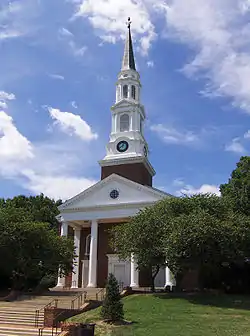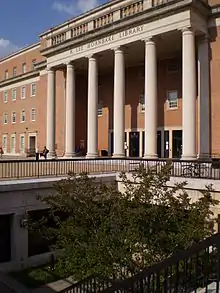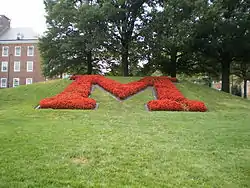University of Maryland, College Park
The University of Maryland, College Park (University of Maryland, UMD, or simply Maryland) is a public land-grant research university in College Park, Maryland.[8] Founded in 1856, UMD is the flagship institution of the University System of Maryland.[9] It is also the largest university in both the state and the Washington metropolitan area, with more than 41,000 students representing all fifty states and 123 countries, and a global alumni network of over 360,000.[10] Its twelve schools and colleges together offer over 200 degree-granting programs, including 92 undergraduate majors, 107 master's programs, and 83 doctoral programs.[11] UMD is a member of the Association of American Universities and competes in intercollegiate athletics as a member of the Big Ten Conference.
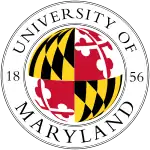 | |
Former names | Maryland Agricultural College (1856–1916) Maryland State College (1916–1920)[1] |
|---|---|
| Motto | Fatti maschii, parole femine (unofficial)[2] |
Motto in English | Strong deeds, gentle words |
| Type | Public flagship land-grant research university |
| Established | March 6, 1856 |
Parent institution | University System of Maryland |
Academic affiliations | AAU ACE APLU BTAA CUWMA Fields Institute ORAU SURA U21 URA Sea-grant Space-grant |
| Endowment | $691.3 million (2019)[3] |
| President | Darryll Pines |
| Provost | Mary Ann Rankin |
Academic staff | 4,610 (Fall 2016)[4] |
Administrative staff | 5,481 (Fall 2016)[4] |
| Students | 41,200 (Fall 2018) |
| Undergraduates | 30,762 (Fall 2018)[5] |
| Postgraduates | 10,438 (Fall 2018)[5] |
| Location | , , United States 38°59′17″N 76°56′41″W |
| Campus | Suburban, 1,340 acres (5.4 km2)[6] |
| Newspaper | The Diamondback |
| Colors | Red, white, gold, black[7] |
| Nickname | Terrapins |
Sporting affiliations | NCAA Division I – Big Ten MAISA |
| Mascot | Testudo |
| Website | umd |
The University of Maryland's proximity to the nation's capital has resulted in many research partnerships with the federal government;[12] faculty receive research funding and institutional support from agencies such as the National Institutes of Health, the National Aeronautics and Space Administration (NASA), the National Institute of Standards and Technology, the Food and Drug Administration, and the Department of Homeland Security.[13][14] It is classified among "R1: Doctoral Universities – Very high research activity"[15] and is labeled a "Public Ivy", denoting a quality of education comparable to the private Ivy League.[16][17] UMD is ranked among the top 100 universities both nationally and globally by several indices.[18][19][20]
In 2016, the University of Maryland, College Park and the University of Maryland, Baltimore formalized their strategic partnership after their collaboration successfully created more innovative medical, scientific, and educational programs,[21] as well as greater research grants and joint faculty appointments than either campus has been able to accomplish on its own.[22][23][24] According to the National Science Foundation, the university spent a combined $1.1 billion on research and development in 2019, ranking it 14th overall in the nation and 8th among all public institutions.[25][26] As of 2021, the operating budget of the University of Maryland is approximately $2.2 billion.[27]
History
Early history
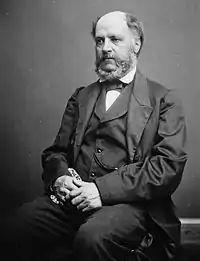
On March 6, 1856, the forerunner of today's University of Maryland was chartered as the Maryland Agricultural College.[28] Two years later, Charles Benedict Calvert (1808–1864), a future U.S. Representative (Congressman) from the sixth congressional district of Maryland, 1861–1863, during the American Civil War and descendant of the first Lord Baltimores, colonial proprietors of the Province of Maryland in 1634, purchased 420 acres (1.7 km2) of the Riversdale Mansion estate nearby today's College Park, Maryland.[29] Later that year, Calvert founded the school and was the acting president from 1859 to 1860.[30] On October 5, 1859, the first 34 students entered the Maryland Agricultural College.[1] The school became a land grant college in February 1864.[1]
Bankruptcy and revival
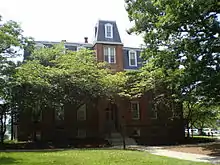
During the Civil War, Confederate soldiers under Brigadier General Bradley Tyler Johnson moved past the college on July 12, 1864 as part of Jubal Early's raid on Washington, D.C.[31] By the end of the war, financial problems forced the administrators to sell off 200 acres (81 ha) of land, and the continuing decline in enrollment sent the Maryland Agricultural College into bankruptcy. For the next two years the campus was used as a boys preparatory school.[1] Following the Civil War, in February 1866 the Maryland legislature assumed half ownership of the school. The college thus became in part a state institution. By October 1867, the school reopened with 11 students. In the next six years, enrollment grew and the school's debt was paid off. In 1873, Samuel Jones, a former Confederate Major General, became president of the college.[32]
Twenty years later, the federally funded Agricultural Experiment Station was established there. During the same period, state laws granted the college regulatory powers in several areas—including controlling farm disease, inspecting feed, establishing a state weather bureau and geological survey, and housing the board of forestry.[1] Morrill Hall (the oldest instructional building still in use on campus) was built the following year.[1]
The Great Fire of 1912
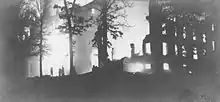
On November 29, 1912, a fire destroyed the barracks where the students were housed, all the school's records, and most of the academic buildings, leaving only Morrill Hall untouched. There were no injuries or fatalities, and all but two students returned to the university and insisted on classes continuing.[1] Students were housed by families in neighboring towns until housing could be rebuilt, although a new administration building was not built until the 1940s.[1] A large brick and concrete compass inlaid in the ground designates the former center of campus as it existed in 1912.
Modern history
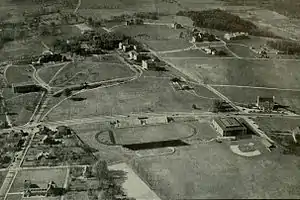
The state took control of the school in 1916, and the institution was renamed Maryland State College. That year, the first female students enrolled at the school. On April 9, 1920, the college became part of the existing University of Maryland, replacing St. John's College, Annapolis as the university's undergraduate campus.[33][34] In the same year, the graduate school on the College Park campus awarded its first PhD degrees and the university's enrollment reached 500 students. In 1925 the university was accredited by the Association of American Universities.[1]
By the time the first black students enrolled at the university in 1951, enrollment had grown to nearly 10,000 students—4,000 of whom were women. Prior to 1951, many black students in Maryland were enrolled at the University of Maryland, Eastern Shore.[35]
In 1957, President Wilson H. Elkins made a push to increase academic standards at the university. His efforts resulted in the creation of one of the first Academic Probation Plans. The first year the plan went into effect, 1,550 students (18% of the total student body) faced expulsion.
On October 19, 1957, Queen Elizabeth II of the United Kingdom attended her first and only college football game at the University of Maryland after expressing interest in seeing a typical American sport during her first tour of the United States. The Maryland Terrapins beat the North Carolina Tar Heels 21 to 7 in the historical game now referred to as "The Queen's Game".[36]
Phi Beta Kappa established a chapter at the university in 1964. In 1969, the university was elected to the Association of American Universities. The school continued to grow, and by the fall of 1985 reached an enrollment of 38,679.[1] Like many colleges during the Vietnam War, the university was the site of student protests and had curfews enforced by the National Guard.[37]
In a massive 1988 restructuring of the state's higher education system, the school was designated as the flagship campus of the newly formed University of Maryland System (later changed to the University System of Maryland in 1997), and was formally named the University of Maryland, College Park. All of the five campuses in the former network were designated as distinct campuses in the new system. However, in 1997 the Maryland General Assembly passed legislation allowing the University of Maryland, College Park, to be known simply as the University of Maryland, recognizing the campus' role as the flagship institution of the University System of Maryland.[38]
The other University System of Maryland institutions with the name "University of Maryland" are not satellite campuses of the University of Maryland, College Park. The University of Maryland, Baltimore, is the only other school permitted to confer certain degrees from the "University of Maryland".
In 1994, the National Archives at College Park completed construction and opened on a parcel of land adjoining campus donated by the University of Maryland, after lobbying by President William Kirwan and congressional leaders to foster academic collaboration between the institutions.[39][40]
21st century
In 2004, the university began constructing the 150-acre (61 ha) "M Square Research Park," which includes facilities affiliated with the U.S. Department of Defense, Food and Drug Administration, and the new National Center for Weather and Climate Prediction, affiliated with The National Oceanic and Atmospheric Administration (NOAA).[41] In May 2010, ground was broken on a new $128-million, 158,068-square-foot (14,685.0 m2) Physical Science Complex, including an advanced quantum science laboratory.[42]
Wallace Loh became president of the university in 2010.[43]
The university's "Great Expectations" campaign from 2006 to 2012 exceeded $1 billion in private donations.[44]
The university suffered multiple data breaches in 2014. The first resulted in the loss of over 300,000 student and faculty records.[45] A second data breach occurred several months later.[46] The second breach was investigated by the FBI and Secret Service and found to be done by David Helkowski.[47] Despite the attribution, no charges were filed. As a result of the data breaches, the university offered free credit protection for five years to the students and faculty affected.[48]
In 2012, the University of Maryland, College Park and the University of Maryland, Baltimore united under the MPowering the State initiative to leverage the strengths of both institutions.[49][50][51] The University of Maryland Strategic Partnership Act of 2016 officially formalized this partnership.[21][23][24]
The University of Maryland's University District Plan, developed in 2011 under President Wallace Loh and the College Park City Council, seeks to make the City of College Park a top 20 college town by 2020 by improving housing and development, transportation, public safety, local pre-K–12 education, and supporting sustainability projects.[52] As of 2018, the university is involved with over 30 projects and 1.5 million square feet of development as part of its Greater College Park Initiative, worth over $1 billion in public-private investments.[53] The university's vision is to revitalize the campus to foster a dynamic and innovative academic environment, as well as to collaborate with the surrounding neighborhoods and local government to create a vibrant downtown community for students and faculty alike.[54][55][56]
In October 2017, the university received a record-breaking donation of $219.5 million from the A. James & Alice B. Clark Foundation, ranking among the largest philanthropic gifts to a public university in the country.[57][58]
As of February 12, 2020, it has been announced that Darryll J. Pines will be the 34th President of the University of Maryland College Park effective July 1, 2020. Darryll J. Pines is the dean of the A. James Clark School of Engineering and the Nariman Farvardin Professor of Aerospace Engineering since January 2009. Darryll J. Pines has been with the University of Maryland College Park for 25 years since he arrived in 1995 and started as an assistant professor.[59]
Academics
Profile
The University of Maryland offers 127 undergraduate degrees and 112 graduate degrees in thirteen colleges and schools:
- A. James Clark School of Engineering
- College of Agriculture and Natural Resources
- College of Arts and Humanities
- School of Languages, Literatures and Cultures
- School of Music
- College of Behavioral and Social Sciences
- College of Computer, Mathematical, and Natural Sciences
- College of Education
- College of Information Studies
- Philip Merrill College of Journalism
- Robert H. Smith School of Business
- School of Architecture, Planning & Preservation
- School of Public Health (formerly the College of Health & Human Performance)
- School of Public Policy
- Office of Undergraduate Studies
- The Graduate School
Undergraduate education is centered on both a student's chosen academic program and the selection of core coursework to fulfill general education requirements.[60]
Programs
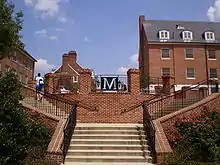
The university hosts "living-learning" programs which allow students with similar academic interests to live in the same residential community, take specialized courses, and perform research in those areas of expertise. An example is the Honors College, which is geared towards undergraduate students meeting high academic requirements and consists of several of the university's honors programs. The Honors College welcomes students into a community of faculty and undergraduates. The Honors College offers seven living and learning programs: Advanced Cybersecurity Experience for Students, Design Cultures and Creativity, Entrepreneurship and Innovation, Honors Humanities, Gemstone, Integrated Life Sciences, and University Honors.[61]
- Advanced Cybersecurity Experience for Students (ACES), started in 2013, is directed by Michel Cukier and run by faculty and graduate students. ACES students are housed in Prince Frederick Hall and take a 14 credit, two year curriculum that educates future leaders in the field of cybersecurity. ACES also offers a complementary two-year minor in cybersecurity.[62]
- Design Cultures and Creativity (DCC), started in 2009, is directed by artist Jason Farman and run by faculty and graduate students. The DCC program encourages students to explore the relationship between emerging media, society, and creative practices.[63] DCC students are housed in Prince Frederick residence hall together and take a 16 credit, two year interdisciplinary curriculum which culminates in a capstone.[64]
- Entrepreneurship and Innovation Program (EIP) is a living and learning program for Honors College freshmen and sophomores, helping build entrepreneurial mindsets, skill sets, and relationships for the development of solutions to today's problems.[65] Through learning, courses, seminars, workshops, competitions, and volunteerism, students receive an education in entrepreneurship and innovation. In collaboration with faculty and mentors who have launched new ventures, all student teams develop an innovative idea and write a product plan.[66]
- Honors Humanities is the honors program for beginning undergraduates with interests in the humanities and creative arts. The selective two-year living-learning program combines a small liberal arts college environment with the resources of a large research university.[67]
- Gemstone is a multidisciplinary four-year research program for select undergraduate honors students of all majors. Under guidance of faculty mentors and Gemstone staff, teams of students design, direct and conduct research, exploring the interdependence of science and technology with society.[68]
- Integrated Life Sciences (ILS) is the honors program for students interested in all aspects of biological research and biomedicine. The College of Computer, Mathematical, and Natural Sciences has partnered with the Honors College to create the ILS program, which offers nationally recognized innovations in the multidisciplinary training of life science and pre-medical students. The objective of the ILS experience is to prepare students for success in graduate, medical, dental, or other professional schools.[69]
- University Honors (UH) is the largest living-learning program in the Honors College and allows students the greatest independence in shaping their education. University Honors students are placed into a close-knit community of the university's faculty and other undergraduates, committed to acquiring a broad and balanced education.[70] Students choose from over 130 seminars exploring interdisciplinary topics in three broad areas: Contemporary Issues and Challenges, Arts and Sciences in Today's World, and Using the World as a Classroom.[71]
- The College Park Scholars programs are two-year living-learning programs for first- and second-year students. Students are selected to enroll in one of 12 thematic programs: Arts; Business, Society, and the Economy; Environment, Technology, and Economy; Global Public Health; International Studies; Life Sciences; Media, Self, and Society; Public Leadership; Science and Global Change; Science, Discovery, and the Universe; Science, Technology, and Society. Students live in dormitories located in the Cambridge Community on North Campus.[72]
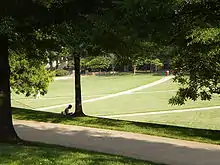
The nation's first living-learning entrepreneurship program, Hinman CEOs, is geared toward students who are interested in starting their own business.[73] Students from all academic disciplines live together and are provided the resources to explore business ventures.
The QUEST (Quality Enhancement Systems and Teams) Honors Fellows Program engages undergraduate students from business, engineering, and computer, mathematical, and physical sciences. QUEST Students participate in courses focused on cross-functional collaboration, innovation, quality management, and teamwork.[74] The Department of Civil & Environmental Engineering (CEE) has also been long considered an outstanding engineering division of the university since its inception in 1908.[75]
Other living-learning programs include: CIVICUS, a two-year program in the College of Behavioral and Social Sciences based on the five principles of civil society;[76] Global Communities, a program that immerses students in a diverse culture (students from all over the world live in a community),[77] and the Language House,[78] which allows students pursuing language courses to live and practice with other students learning the same language.
The Mock Trial Team engages in intercollegiate mock trial competition. The team, which first began competing in 1990, has won five national championships (2008, 2000, 1998, 1996, 1992), which ranks the most of any university,[79] and was also the national runner-up in 1992 and 1993.[80]
Faculty
The university's faculty has included four Nobel Prize laureates. The earliest recipient, Juan Ramón Jiménez, was a professor of Spanish language and literature and won the 1956 prize for literature. Four decades later, physics professor William Daniel Phillips won the prize in physics for his contributions to laser cooling, a technique to slow the movement of gaseous atoms in 1997. In 2005, professor emeritus of economics and public policy Thomas Schelling was awarded the prize in economics for his contributions to game theory. In 2006, adjunct professor of physics and senior astrophysicist at NASA John C. Mather was awarded the prize in physics alongside George Smoot for their work in the discovery of blackbody form and anisotropy of the cosmic microwave background radiation. In addition, two University of Maryland alumni are Nobel Prize laureates; Herbert Hauptman won the 1985 prize in chemistry and Raymond Davis Jr. won the 2002 prize in physics.
The university has many notable academics. Professor of mathematics Sergei Novikov won the Fields Medal in 1970 followed by alumnus Charles Fefferman in 1978. Alumnus George Dantzig won the 1975 National Medal of Science for his work in the field of linear programming. Professor of physics Michael Fisher won the Wolf Prize in 1980 (together with Kenneth G. Wilson and Leo Kadanoff) and the IUPAP Boltzmann Medal in 1983. James A. Yorke, a Distinguished University Professor of Mathematics and Physics and chair of the Mathematics Department won the 2003 Japan Prize for his work in chaotic systems. In 2013, professor of Physics Sylvester James Gates was awarded the National Medal of Science.[81]
Research
On October 14, 2004, the university added 150 acres (61 ha) in an attempt to create the largest research park inside the Washington, D.C., Capital Beltway, known as "M Square."[82]
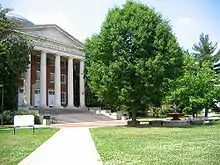
Many of the faculty members have funding from federal agencies such as the National Science Foundation, the National Institutes of Health,[83] NASA,[84] the Department of Homeland Security,[85] the National Institute of Standards and Technology, and the National Security Agency. These relationships have created numerous research opportunities for the university including:
- taking the lead in the nationwide research initiative into the transmission and prevention of human and avian influenza.[86]
- creating a new research center to study the behavioral and social foundations of terrorism with funding from the U.S. Department of Homeland Security
- launching the joint NASA-University of Maryland Deep Impact spacecraft in early January 2005.
The University of Maryland Libraries provide access to scholarly information resources required to meet the missions of the university.
The University of Maryland is an international center for the study of language, hosting the largest community of language scientists in North America, including more than 200 faculty, researchers, and graduate students, who collectively comprise the Maryland Language Science Center under the leadership of Professor Colin Phillips. Since 2008 the university has hosted an NSF-IGERT interdisciplinary graduate training program that has served as a catalyst for broader integrative efforts in language science, with 50 participating students and contributions from 50 faculty. The University of Maryland is also home to two key 'migrator' centers that connect basic research to critical national needs in education and national security: the Center for Advanced Study of Language (CASL) and the National Foreign Language Center (NFLC).
The Center for American Politics and Citizenship provides citizens and policy-makers with research on issues related to the United States' political institutions, processes, and policies. CAPC is a non-partisan, non-profit research institution within the Department of Government and Politics in the College of Behavioral and Social Sciences.
The Space Systems Laboratory researches human-robotic interaction for astronautics applications, and includes the only neutral buoyancy facility at a university.
The Joint Quantum Institute conducts theoretical and experimental research on quantum and atomic physics. The institute was founded in 2006 as a collaboration between the University of Maryland and the National Institute of Standards and Technology (NIST).[87]
The Center for Technology and Systems Management (CTSM) aims to advance the state of technology and systems analysis for the benefit of people and the environment. The focus is on enhancing safety, efficiency and effectiveness by performing reliability, risk, uncertainty or decision analysis studies.
The Joint Global Change Research Institute was formed in 2001 by the University of Maryland and the Pacific Northwest National Laboratory. The institute focuses on multidisciplinary approaches of climate change research.
The Center for Advanced Life Cycle Engineering (CALCE) was formed in 1985 at the University of Maryland. CALCE is dedicated to providing a knowledge and resource base to support the development of electronic components, products and systems.
The National Consortium for the Study of Terrorism and Responses to Terrorism (START) launched in 2005 as one of the Centers of Excellence supported by the Department of Homeland Security in the United States. START is focused on the scientific study of the causes and consequences of terrorism in the United States and around the world.[88]
Admissions
Admission to Maryland is rated "more selective" by U.S. News & World Report.[89] The university received 28,301 applications for the Class of 2019 (entering Fall 2015) and admitted 12,637 (44.7%) of applicants, with 3,937 enrolled, creating an admissions yield of 31%. For the Class of 2019, the middle 50% range of SAT scores of the enrolling freshmen was 590–690 for critical reading and 620–730 for math; the average high school grade point average (GPA) was 4.22.[90] Beginning with the 2017-18 admissions cycle, the University of Maryland uses the application provided by The Coalition for Access, Affordability, and Success,[91] joining over 130 top public and private universities using the platform to streamline the college application process.[92][93] Starting in August 2018, the University of Maryland will waive the college application fee for U.S. military veterans and current service members applying for the 2019–2020 academic year.[94] According to The Washington Post in 2017, the University of Maryland in 2016 was more selective than in recent decades as the general increase in public school applications had helped Maryland then rise in apparent prestige, at the time appearing to be the ninth most selective public flagship university in the nation. Of course, this selectivity prestige was based on number of applicants versus those accepted, but not the quality of applicants.[95]
Rankings
| University rankings | |
|---|---|
| National | |
| ARWU[96] | 31 |
| Forbes[97] | 63 |
| THE/WSJ[98] | 75 |
| U.S. News & World Report[99] | 58 |
| Washington Monthly[100] | 50 |
| Global | |
| ARWU[101] | 53 |
| QS[102] | 152 |
| THE[103] | 91 |
| U.S. News & World Report[104] | 51 |
|
USNWR graduate school rankings[105] | |
|---|---|
| Biological Sciences | 62 |
| Business | 44 |
| Chemistry | 41 |
| Clinical Psychology | 33 |
| Computer Science | 16 |
| Criminology | 1 |
| Earth Sciences | 28 |
| Economics | 21 |
| Education | 27 |
| Engineering | 20 |
| English | 30 |
| Fine Arts | 110 |
| History | 27 |
| Library & Information Studies | 8 |
| Mathematics | 22 |
| Physics | 14 |
| Political Science | 29 |
| Psychology | 39 |
| Public Affairs | 32 |
| Public Health | 32 |
| Sociology | 24 |
| Speech-Language Pathology | 16 |
The university is ranked as tied for 58th in the 2021 U.S. News & World Report rankings of "National Universities" across the United States, and it is ranked tied for 19th nationally among public universities.[106] The Academic Ranking of World Universities ranked Maryland as 43rd in the world in 2015. The 2017–2018 Times Higher Education World University Rankings placed Maryland 69th in the world. The 2016/17 QS World University Rankings ranked Maryland 131st in the world.
The university is ranked among Peace Corps' 25 Top Volunteer-Producing Colleges for the seventh consecutive year in 2018.[107][108] The University of Maryland is ranked among Teach for America's Top 20 Colleges and Universities contributing the greatest number of graduating seniors to its 2017 teaching corps.[109] Kiplinger's Personal Finance 100 Best Values in Public Colleges 2015 ranked the University 9th for in-state students.[110]
For the fourth consecutive year in 2015, the university is ranked 1st in the U.S. for the number of Boren Scholarship recipients – with 9 students receiving awards for intensive international language study.[111] The university is ranked as a Top Producing Institution of Fulbright U.S. Students and Scholars for the 2017–2018 academic year by the United States Department of State's Bureau of Educational and Cultural Affairs.[112][113]
In 2017, the University of Maryland was ranked among the top 50 universities in the 2018 Best Global Universities Rankings by U.S. News & World Report based on its high academic research performance and global reputation.[114][115]
In 2018, the university was ranked among the top 10 universities in The Princeton Review's annual survey of the Top Schools for Innovation & Entrepreneurship; this was the third consecutive such ranking.[116][117]
Campus
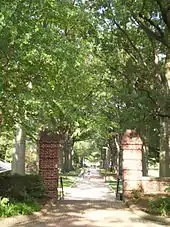
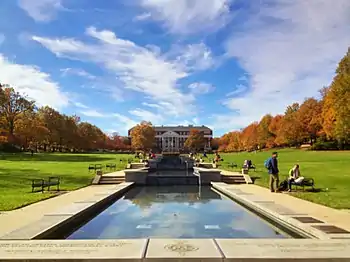
The campus of the university is noted for its red-brick Georgian buildings and its large central lawn, named McKeldin Mall and nicknamed "The Mall", which is the largest academic mall in the United States.[118][119] White columns decorate many buildings, with around 770 columns existing on campus.[120] Spanning the university's 1,250 acres (5.1 km2) are 7,500 documented trees and garden plantings, leading the American Public Gardens Association to designate the campus the University of Maryland Arboretum & Botanical Garden in 2008.[121] The designation has allowed the university to showcase species and gardens, including native plantings. There are arboretum tours, such as the centralized Tree Walking Tour which is based around McKeldin Mall and features 56 specimen trees.
Additionally, there are nearly 400 acres (1.6 km2) of urban forest located on campus[121] and the Arbor Day Foundation has named the university to its 'Tree Campus USA' list.[122] The recreational Paint Branch Trail, part of the Anacostia Tributary Trails system, cuts through campus, as does the Paint Branch stream, a tributary of the Northeast Branch Anacostia River.[123]
McKeldin Mall serves as the center of campus. On the east and west ends of McKeldin Mall lie the Main Administration Building and McKeldin Library. Academic buildings surround McKeldin Mall on the north and south ends, and are the homes to many departments in the College of Behavioral and Social Sciences, College of Arts and Humanities, and the College of Agriculture and Natural Resources. West of McKeldin Mall is the North Hill Community, and south of McKeldin Mall lies Morrill Hall and the Morrill Quad, which was the original center of campus. South of the Morrill Quad are the South Hill and South Campus Commons Communities, and to the southwest is the Southwest Mall and the Robert H. Smith School of Business. Running parallel to McKeldin Mall to the north is Campus Drive, the main thoroughfare through campus.
The Adele H. Stamp Student Union sits along Campus Drive near the center of campus, and serves as a transit center for campus, where Shuttle-UM (the university's bus service) and municipal buses pick up and drop off passengers. Hornbake Plaza home to Hornbake Library and several buildings housing academic departments also lies on Campus Drive, east of Stamp. Stamp serves as a center which includes a food court, bowling alley, book store, and spaces made available for major events such as freshman orientation or career fairs.
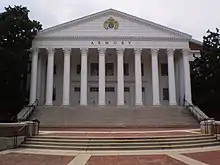
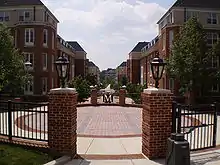
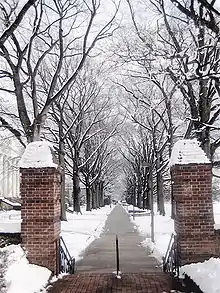
Outside of the Stamp Student Union on Campus Drive is the Jim Henson Statue and Memorial Garden, in honor of the late Jim Henson, a Maryland alumnus. A likeness of Henson is seated on a park bench, facing arguably his most famous creation, Kermit the Frog.[124] To the north and northwest of Stamp and Hornbake Plaza are the North Campus communities, Maryland Stadium, the Eppley Recreation Center (the main gym on campus), the XFINITY Center, and the Wooded Hillock, a 22-acre (8.9 ha) forest located next to the XFINITY Center; Stadium Drive runs between the more southern Maryland Stadium and the rest of these. The Clarice Smith Performing Arts Center sits to the west of Maryland Stadium.
Another thoroughfare, Regents Drive, runs perpendicular to McKeldin Mall and is home to the Memorial Chapel and the Campus Farms. Regents Drive crosses Campus Drive at the campus hallmark "M" Circle, which is a traffic circle with a large "M" formed by flowers in its center.[125] The northeast quadrant of campus, formed by Campus and Regent Drives, is home to many of natural sciences and applied sciences departments.
The university is also divided by U.S. Route 1, known locally as "Baltimore Avenue." While most of campus lies to the west of Baltimore Avenue, fixtures such as fraternity row and the Leonardtown Communities lie to the east. Sitting on the western edge of Baltimore Avenue are the Visitors' Center, also known as The Dairy, The Reckord Armory, and The Rossborough Inn, which, built during the years of 1798 to 1812, is the oldest building on campus (and is older than the university itself).[126] There are five regularly used entrances to campus; the main entrance, off of Baltimore Avenue and onto Campus Drive, is referred to as North Gate and features the Gatehouse, an ornate gateway honoring the university's founders.[127] The 140-acre (57 ha), 18-hole University of Maryland Golf Course sits at the northern edge of campus, as does the Observatory. The campus is also home to one of the root servers, responsible for operating DNS.
Sustainability
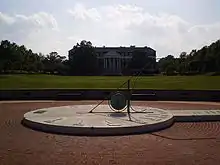
The four-person Office of Sustainability was created in summer 2007 after University President Dan Mote became charter signatory of the American College and Universities Presidents Climate Commitment (ACUPCC) with the goal of campus climate neutrality. The Climate Action Plan Work Group completed an inventory of campus emissions from 2002 to 2007, and finalized a Climate Action Plan in August 2009.[128] According to the university's Climate Action Plan, Maryland aims to become carbon neutral by 2050.[129] All new constructions and major renovations must satisfy LEED-Silver certification requirements. The office has promoted several initiatives, including an increase in the campus recycling rate from 17% in 2003 to 89% in 2014.[130] In 2008, the recycling rate rose from 37% to a 54% due in part to the "Feed the Turtle" program for home football games.[131] Although recycling rates have increased across campus, not every bin is able to be recycled due to high contamination rates on some parts of campus. For example, as of 2017, the Stamp Student Union had 54% contamination rates in their recycling bins, which means that over half of the waste in the recycling bins at Stamp had to be thrown into the trash.[132] Power Shift, a national youth climate activism summit, was held at the University of Maryland in November 2007 with 6,000 individuals in attendance.[133]
The university's first Leed Gold building, Knight Hall, opened in April 2010 as the new home for the Philip Merrill College of Journalism.[134][135] The university added solar panels in the spring of 2010 to the roof of "The Diner" dining hall in North Campus, and plans to add solar panels to the roof of Cole Field House, as well as additional campus buildings.[136] The university's announced 158,068-square-foot (14,685.0 m2) state-of-the-art Physical Sciences Complex (set to be completed in July 2013) will meet LEED-Silver certification requirements.[137][138]
In 2008, the Office of Sustainability started the Sustainability Advisors program, in which teachers invite a peer educator to give a lecture covering sustainability concepts.[139]
The Office of Sustainability began an initiative called "The Chesapeake Project" in 2009, in which professors integrate sustainability education into pre-existing classes across every discipline.[140] Participating professors attend a two-day workshop in late May to learn about environmental, economic, and social sustainability.[140] All participants receive a $500 stipend. By the end of summer, workshop participants submit a revised course plan for at least one course offered the following academic year. Since the inaugural workshop in 2009, 71 professors have participated in the program, implementing sustainability education into over 80 courses across all 12 colleges at the school.[140]
In 2003, bioretention facilities were installed in the campus with collaboration from the Prince George's County Department of Environmental Resources. Since this time, research has continued on the effectiveness of these bioretention sites in controlling water flow and filtering pollutants. A prime example is the research of Professor Allen Davis in the Department of Civil and Environmental Engineering, which has examined and improved upon the removal of contaminants with rain gardens.[141]
Starting in 2010, the University System of Maryland and the Department of General Services began three projects that were to be continued for the next twenty years. The three projects included: a solar project in Mount St. Mary's University, a wind project in Western Maryland, and another wind project in West Virginia. The first of these projects, the solar project, is a 16 megawatt project. The first wind project is 10 megawatts, and the second is 55 megawatts.
The projects will allow the university to receive 15 percent of their purchased energy from these renewable energy resources. Also in 2010, Ellicott Dining Hall installed solar panels which would provide up to 30 percent of the energy for heating its water. The university installed 20 panels with three solar storage tanks, pumps, temperature sensors, and controls. The system will increasingly provide more of the dining hall's water needs.[140]
In 2011, Maryland's team won the Solar Decathlon, a competition put on by the U.S. Department of Energy.[142][143] The team designed and built a solar-powered home with a split butterfly roof in a project called "WaterShed."[144] The house was "inspired and guided by the Chesapeake Bay ecosystem, interconnecting the house with its landscape, and leading its dwellers toward a more sustainable lifestyle."[145] Over 200 students contributed to the project. Maryland's design beat out submissions from 20 other universities from all over the world, including China, New Zealand, Belgium, and Canada.[142]
In the 2017 Solar Decathlon, the University of Maryland's team won 1st place in the U.S. and 2nd place in the world.[146][147] The 100% solar powered house, named "resilient Adaptive Climate Technology" (reACT), was largely inspired by the environmentally conscious traditions of the Nanticoke people and other local Native American tribes in Maryland, such as water reuse, home gardening, and composting.[147]
Maryland also promotes the use of reusable to-go containers at the dining hall, or OZZI containers, since the official launching of the program in August 2011.[148] Students pay a $5 fee to initially use the container, but receive a coin when they return it to the dispenser. With the coin, the use of the container is cost-free.
In January 2011, Maryland installed occupancy sensors in nearly all of the 300 general-purpose classrooms.[149] These occupancy sensors automatically turn off the lights after 30 minutes if there is no motion in a room. The project is estimated to cut energy consumption by 30 percent and save the university $100,000 annually.[149]
In 2012, the University Sustainability fund granted $130,000 to projects that promote sustainability.[150] The money was generated from an $8 mandatory sustainability fee, a fee that will increase to $12 by 2014. Mark Stewart, Project Manager at the Office of Sustainability, expects the fund to grow to $300,000 by 2013.[150]
On May 2, 2012 the Wellness Coalition hosted its first Farmers Market at Maryland, a weekly tradition that supplies produce from farms in Maryland, Pennsylvania, and Virginia.[151] Its first day saw over 1,000 visitors.[152]
In October 2013 the university's College of Behavioral and Social Sciences (BSOS) became the university's first college to form their own Sustainability Task Force. In April 2014 the Task Force produced BSOS's Sustainability Plan to advance campus sustainability and complement the university's Climate Action Plan to help the university become a national model of a green university. It is the first plan of its kind at the college level at the university, and was designed to serve as a guide for other colleges to join BSOS in this effort to improve the sustainability of the campus and community as a whole.[153] In September 2014 the BSOS Sustainability Task Force expanded to include a student Sustainability Task Force. The student Task Force is an interdisciplinary team focused on addressing sustainability problems on campus.[154]
In August 2015, compost bins were placed in two residence halls, and, after a successful year, were placed in nine other residence halls in August 2016.[155] As of 2017, the University of Maryland increased its compost collection by nearly 450% since 2010.[156] While efforts have been made to add composting collection sites on campus in academic buildings and residence halls, many have been removed due to high contamination rates. Some Greek life houses as well as some on-campus apartment buildings used to have composting, but in 2017 and 2018 many of them had to be removed since they were causing more harm than good.[157]
Student life
Residential life
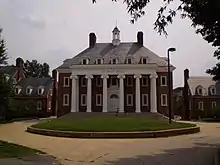
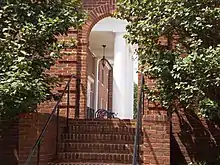
There are two main residential areas on campus, North Campus and South Campus, which are further divided into seven residential communities. North Campus is made up of Cambridge Community (which consists of five residence halls), Denton Community (which currently consists of four halls, including Oakland hall which opened in the fall semester of 2011), and Ellicott Community (consisting of three halls).
South Campus includes the North Hill Community, made up of nine Georgian-style halls and Prince Frederick hall (which opened in the fall semester of 2014) located immediately west of McKeldin Mall, South Hill Community, made up of fourteen small residence halls for upperclassmen, Leonardtown Community, which offers apartment-style living and is further divided into Old Leonardtown (consisting of six buildings) and New Leonardtown (also consisting of six buildings), the South Campus Commons Community, which consists of seven apartment-style buildings (the seventh and most recent building being opened in January 2010), and the Courtyards, a garden style apartment community in north campus consisting of seven buildings.
The South Campus Commons Community and Courtyards, while built on campus, are managed by a private company, Capstone On-Campus Management, as part of a public-private partnership between the company and the University of Maryland.
The university does not have family housing. As of 2011, some students with families have advocated for the addition of family housing.[158]
Residential life is overseen by the Department of Resident Life, which consists of a staff members and departments. For instance, resident assistants, who are full-time undergraduates facilitating the student interaction and development of floors within their assigned floor, building, or community, are supervised by resident directors. The Department of Resident Life offers its residents and other students many programs, including the Math Success Program, Academic Success Program, Common Ground Dialogue Program, and many Living and Learning programs.[159]
Dining
There are three dining halls on campus: the North Campus Dining Hall ("The Diner") is located between the Ellicott Community, the South Campus Dining Hall is located near the South Hill and South Campus Commons communities, and the 251 North Dining Hall is located in the Denton Community. As of the fall of 2016, the University of Maryland Dining Services changed their dining plan from a pay a la carte to an all-you-can-eat style dining experience. A food court in the Stamp Student Union provides a plethora of dining options for the university community. The Maryland Food Collective, popularly known as the Co-Op, is a worker-owned collective that has been providing a wide array of vegan and vegetarian food options, along with local, organic, and fair-trade fruits and vegetables since 1975 but then closed in 2019.[160][161]
Transportation

The university is accessible through the three airports which exist in the greater Washington metropolitan area: Ronald Reagan Washington National Airport, Washington Dulles International Airport, and Baltimore–Washington International Thurgood Marshall Airport.[162] A small public airport in College Park, College Park Airport, lies nearly adjacent to campus, but operations are limited to the Washington metropolitan area. The College Park Airport is the oldest continually operating airport in the world and the site of many significant aviation firsts.[163][164]
A free shuttle service, known as Shuttle-UM, is available for UMD students, faculty, staff, and some residents of College Park and Greenbelt.[165][166] The university is served by an off-campus stop on the Washington Metro Green Line and Yellow Line called College Park – University of Maryland. The station is also served by the Camden Line of the MARC Train, which runs between Baltimore and Washington. A Shuttle-UM bus (Route 104) arrives at the station every five minutes during fall and spring semesters (every ten minutes during the summer) to bring visitors to campus (stopping in front of the Stamp Student Union).
Metrobus and Prince George's County TheBus bus services also stop on campus. Beginning in early 2012, TheBus services for Route1Ride (Route 17) were made free of charge to all University of Maryland students and staff, providing service on Route 1 from the Washington, D.C. border to the IKEA in College Park, with a stop at the College Park–University of Maryland Metro station.[167][168] There is an additional service called Nite Ride which is a curb-to-curb service offered every night from 5:30 p.m. to 7:30 a.m. The service is designed to serve the areas of campus that are not included on the evening service routes.
Over 21,000 parking spaces are on campus, in parking lots and garages.[169] There are a total of 16 electric vehicle charging stations on campus in 7 locations that are free and open to the public, with plans to add more stations.[170] Zipcar service is also available on campus for all UMD students, faculty, and staff.[171]
The university has been attempting to make the campus more bike-friendly by installing covered bike parking and bike lockers on campus,[172] introducing a bike-sharing program,[173] and plans to add more bike lanes on campus.[174] As of Spring 2011, the university has encouraged cycling on campus by installing covered bike storage outside of the newly built Oakland dorm as well as security lockers in the Mowatt Lane Garage.[175][176] In addition to increased storage options, the university runs the Campus Bike Shop where students can get their bikes repaired and learn how to maintain them on their own.[177] Since 2014, the University of Maryland has been named a gold-level "Bicycle Friendly University" by the League of American Bicyclists.[178][179]
As of Fall 2019, electric scooter stations were placed around campus in order to facilitate the introduction of an electric scooter, hybrid bike, and manual bike sharing system on campus. Over the course of the semester, private scooter companies introduced and slowly increased the number of scooters and bikes available for rental on campus. All the bikes and scooters for pay-by-the-minute rental are only available between 5:00 am and 9:00 pm each day. Over the Fall 2019 semester personal scooters have also seen a drastic increase on campus.
Under the administration of former President C. Daniel Mote Jr., the university was the primary source of opposition in Prince George's County to the installation of one or more light-rail stops on campus as a part of the proposed Maryland Transit Administration's Purple Line out of concern for student safety and to protect sensitive lab equipment.[180][181] This sentiment was similar to previous transit positions taken by the university in the 1980s, specifically when the administration rejected Metro's first proposal of having the College Park–University of Maryland station run underground through campus connecting to Adele H. Stamp Student Union, and strongly opposed their second proposal to put the stop right next to campus in downtown College Park on Route 1, with the reasoning to protect student and resident safety.[182][183]
In 2017, former Maryland Governor and Prince George's County Executive Parris Glendening admitted that the decision made by the university to have the Metro station as far away from campus as possible (1.6 miles) was a "disaster" and racially biased, largely due to administrators and community residents saying they did not want crime or undesirable people coming to campus on the Green Line from the poorer neighborhoods of Washington.[183][184]
Under President Wallace Loh's vision in 2011, the administration recognized the transit mistakes of the past and embraced having the Purple Line on campus as it would drastically increase transportation access for students and faculty, while encouraging more walkable transit-oriented developments in downtown College Park.[182] The Purple Line route, which is expected to be completed in the fall of 2022, will have five stops on and around the university's campus: M Square, the College Park Metro station, the main entrance to the campus on Route 1, near Stamp Student Union on Campus Drive, and on the other edge of campus on Adelphi Road.[185][186][187]
The Diamondback
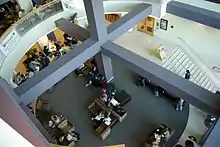
The Diamondback is an independent student newspaper. It was founded in 1910 as The Triangle and renamed in 1921 in honor of a local reptile, the Diamondback terrapin, which became the school mascot in 1933. The newspaper is published daily Monday through Friday during the spring and fall semesters, with a print circulation of 17,000 and annual advertising revenues of over $1 million.[188] It has four sections: News, Opinion, Sports, and Diversions.
For the 2008–2009 school year, The Diamondback earned a Mark of Excellence award from the Society of Professional Journalists, placing second nationally for Best All-Around Daily Student Newspaper and first in its region in the same category.[189] Three years earlier the newspaper had finished third place nationally for Best All-Around Daily Student Newspaper and first in its region.[190]
Notable journalists who have been with the paper include David Simon of HBO's The Wire and NBC's Homicide: Life on the Street; disgraced Jayson Blair, who was editor-in-chief in 1996 (he did not graduate, instead taking a job with The New York Times); Norman Chad, who was editor-in-chief in 1978; cartoonists Jeff Kinney, who created the Diary of a Wimpy Kid fiction series and whose Igdoof strip appeared in The Diamondback; Aaron McGruder, who first published his cartoon The Boondocks in The Diamondback; and Frank Cho, who began his career with the popular University Squared for The Diamondback.
WMUC-FM
WMUC-FM (88.1 FM) is the university non-commercial radio station, staffed by UMD students and volunteers. WMUC is a freeform radio station that broadcasts at 10 watts. Its broadcasts can be heard throughout the Washington metropolitan area. Notable WMUC alumni include Connie Chung, Bonnie Bernstein, Peter Rosenberg and Aaron McGruder.
WMUC Sports
WMUC Sports is the online sports division of WMUC-FM that provides live broadcasts for over 10 Division I University of Maryland sports, including the Terrapin football and basketball teams.
Greek life
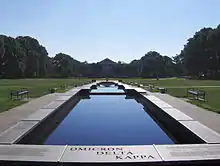
Approximately 15% of men and 20% of women in Maryland's undergraduate student body are involved in Greek life.[191] Many of the fraternities and sororities at the school are located on Fraternity Row and the Graham Cracker, which are controlled by the university. Fraternity Row is the background of several recently produced films.
All social Greek organizations are governed by one of five groups: the Inter-Fraternity Council, the Panhellenic Association, the Pan-Hellenic Council, the United Greek Council, or the Professional Fraternal Association. All cultural Greek organizations are governed by the United Greek Council. These councils assist in the creation and governance of chapter by-laws, risk management plans, and philanthropic activities, with support from the Department of Fraternity and Sorority Life.[192][193] Each year, every Greek organization must fulfill certain requirements, including doing a service and conducting a program/event related to community service, diversity, or alumni and faculty outreach.
| List of sororities | List of fraternities | ||
|---|---|---|---|
|
|
|
|
A cappella groups
UMD hosts ten student-run a cappella groups on campus, several of which compete regularly in the International Championship of Collegiate A Cappella (ICCA). The most prominent of these groups is the mixed ensemble Faux Paz, who placed 3rd at ICCA finals in New York City in 2016.[194] In 2020, The A Cappella Archive ranked Faux Paz at #10 out of all ICCA-competing groups.[195]
Athletics
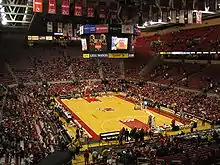
The university sponsors varsity athletic teams in 20 men's and women's sports. The teams, named the "Terrapins," represent Maryland in National Collegiate Athletic Association Division I competition. Maryland became a founding member of the Atlantic Coast Conference in 1952, but left to join the Big Ten Conference on July 1, 2014. As of 2017, Maryland's athletic teams have been awarded 44 national championships by the NCAA, USILA, AIAW, and NCA.[196][197] In 2008 and 2010, The Princeton Review named the University of Maryland's athletic facilities the best in the nation.[198][199] The Terrapins nickname (often shortened to "Terps") was coined by former university president, football coach, and athletic director H. C. "Curly" Byrd in 1932.[200] The mascot is a diamondback terrapin named Testudo, which is Latin for "tortoise."[201] Since the early 20th century, the school athletic colors have been some combination of those on the Maryland state flag: red, white, black, and gold.[202]
Men's basketball

Men's basketball is one of the most popular sports at the university.[203] Long-time head coach Lefty Driesell began the now nationwide tradition of "Midnight Madness" in 1971.[204] Beginning in 1989, alumnus Gary Williams revived the program, which was struggling in the wake of Len Bias's death and NCAA rules infractions. Williams led Maryland basketball to national prominence with two Final Four appearances, and in 2002, a national championship. On February 7, 2006, Williams won his 349th game to surpass Driesell and became Maryland's all-time leader among basketball coaches. In May 2011, Williams retired as head coach, which allowed for the entrance of the new head coach, Mark Turgeon. The court at XFINITY Center was named in honor of the beloved coach, Gary Williams. Maryland football is also popular at the university.[203] The Terrapins were awarded the national championship by the wire services in 1953, and in 1951, by several retroactive selectors.
Beyond the two "revenue sports," the university fields 18 other varsity teams. The women's basketball team rose to prominence in the 2000s (decade), and head coach Brenda Frese guided the Lady Terps to their first NCAA title in 2006.[205]
Men's lacrosse
Maryland men's lacrosse remains one of the sport's top programs since its beginnings as a squad in 1865.[206] The team most recently won the national championship in 2017, breaking a 42-year drought. The team has won ten USILA and NCAA national championships since its promotion to varsity status in 1924 and is a regular fixture in the NCAA tournament.[207][208] The women's lacrosse team has the most national championships of any program in the nation, including most recently in 2017.[209][210]
Men's soccer
The men's soccer team has won four NCAA Division I College Cup national championships, most recently in 2018.[211] Under the guidance of head coach Sasho Cirovski, the soccer team has reached nine Final Fours and won three College Cups since 1997. The soccer team has developed a large, devoted fan base among students and the local community. The attendance record at Ludwig Field was set in 2015 when 8,449 fans saw Maryland win over top-ranked UCLA in extra time.[212] The annual total attendance increased dramatically from 12,710 in 1995 to 35,631 in 2008.[213]
Field hockey
The Maryland women's field hockey team has won eight NCAA championships.[214]
The Mighty Sound of Maryland marching band attends all home football games and provides pre-game performances.[215] During basketball season, the marching band becomes the University of Maryland Pep Band, which provides music in the stands at men's and women's home games and during tournament play.[216]
On July 1, 2012, the university cut seven varsity teams: men's cross country, men's indoor track, men's swimming and diving, men's tennis, women's acrobatics and tumbling, women's swimming and diving, and women's water polo. The men's outdoor track team had been scheduled to be cut, but the team raised $888,000 of a target amount of $940,000, sufficient to avoid elimination.[217]
Mascot
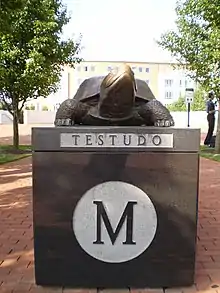
In 1932, Curley Byrd—who served as the university's football and baseball coach, athletic director, and president—proposed adopting the diamondback terrapin as a mascot. The first statue of Testudo cast in bronze was donated by the Class of 1933 and displayed on Baltimore Avenue in front of Ritchie Coliseum. However, the 300-pound sculpture was subjected to vandalism by visiting college athletic teams.[218] One such incident occurred in 1947 when students from Johns Hopkins University stole the bronze statue and moved it to their campus. Maryland students traveled to Baltimore to retrieve it, laying siege to the house where it was hidden. Over 200 city police responded to quell the riot.[219] In 1949, University President Byrd was awakened by a phone call from a University of Virginia fraternity requesting that Testudo be removed from their lawn. Testudo was later filled with 700 pounds of cement and fastened to his pedestal to prevent future removals, but students at rival schools continued to vandalize it. It was moved to Maryland Stadium in 1951. In the 1960s, Testudo was moved back to a central spot in front of McKeldin Library.[220][221][222][223]
In 1992 a duplicate statue was placed at Maryland Stadium, where the football team touch it for good luck as they pass by before games. Additional Testudo statues now sit outside of the Gossett Team House near the stadium; XFINITY Center, the school's basketball arena; the Riggs Alumni Center; in the lobby of the Adele H. Stamp Student Union; and on the courtyard of Van Munching Hall.[222][224] In 1994, the Maryland General Assembly approved legislation to name the diamondback terrapin (malaclemys terrapin terrapin) as the official state reptile and the legally codified mascot of the University of Maryland.[225] Beginning in the 2000s, the university promoted the slogan "Fear the Turtle" as a rallying cry for school pride.[226]
The statue's nose is polished by passers-by that have rubbed it for good luck.[227] Around finals week, students start giving offerings to Testudo in the hope of good grades. In 2013, the Testudo statue caught fire because of an ill-advised mixture of offerings and a lit candle. Local news channels reported about this event and it trended on Twitter.[228] During the COVID-19 pandemic, campus guidelines included instructions to not rub the statue's nose unless using disinfectant wipes before and after to clean it.[229][230]
Notable alumni
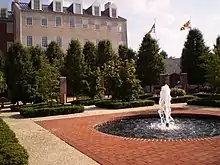
Notable alumni include House Democratic Whip Steny Hoyer;[231] Google co-founder Sergey Brin;[232] The Muppets creator Jim Henson;[233] The Wire creator David Simon,[234] as well as Seinfeld co-creator and Curb Your Enthusiasm creator Larry David.[235] Former NFL Quarterback Norman "Boomer" Esiason. Prominent alumni in business include Ed Snider, Chairman of Comcast Spectacor and owner of the Philadelphia Flyers; Jim Walton (journalist), former president and CEO of CNN; Kevin Plank, founder and executive chairman of the athletic apparel company Under Armour; Leonard Kevin "Len" Bias, a first team All-American college basketball forward; Chris Kubasik, former President of Lockheed Martin; Carly Fiorina, former CEO of Hewlett-Packard; and telecommunications entrepreneur Brian Hinman.[236]
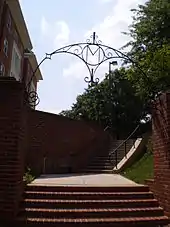
Television personality Connie Chung; E! News reporter Giuliana Rancic graduated with a bachelor's degree from the Philip Merrill College of Journalism. ESPN reporters Bonnie Bernstein and Tim Kurkjian graduated from the Philip Merrill College of Journalism, as did Peter Rosenberg. Scott Van Pelt, also of ESPN, attended the Phillip Merrill College of Journalism, but finished a few credits short of graduation.
Journalist Carl Bernstein, who won the Pulitzer Prize for Public Service for his coverage of the Watergate scandal, attended the university but did not graduate. Mark Rosenker, Former Chairman of the National Transportation Safety Board (NTSB) and now CBS NEWS Transportation Safety Analyst graduated with a Bachelor of Arts in radio and television. Kiran Chetry, co-host of CNN's American Morning, graduated with a Bachelor of Arts in broadcast journalism. Jean Worthley of Maryland Public Television hosted Hodgepodge Lodge and co-hosted On Nature's Trail after enrolling in the Graduate School of Education. TV and media critic David Zurawik of The Baltimore Sun graduated with a doctorate in American Studies.
Heidi Collins of CNN Newsroom graduated with a Bachelor of Science. Former Maryland governor Harry R. Hughes also attended. Gayle King, editor-at-large for O, The Oprah Magazine, graduated from Maryland with a degree in psychology. Television show host Bruce DePuyt, host of News Talk on NewsChannel8 graduated from Phillip Merrill College of Journalism.
Attendees within the fields of science and mathematics are Nobel laureates Raymond Davis Jr., 2002 winner in Physics; Herbert Hauptman, 1985 winner in Chemistry, and Fields Medal winner Charles Fefferman. Other alumni include George Dantzig, considered the father of linear programming; late NASA astronaut Judith Resnik, who died in the destruction of the Space Shuttle Challenger during the launch of mission STS-51-L; engineer James S. Albus, founder of a division at the National Institute of Standards and Technology (NIST); NASA Administrator Michael D. Griffin; Sara Hallager, curator of birds at the Smithsonian's National Zoo;[237] and Kevin Greenaugh, first African American to receive a doctorate in nuclear engineering from the University of Maryland.
Several donors have distinguished themselves for their sizable gifts to the university. Businessman Robert H. Smith, who graduated from the university in 1950 with a degree in accounting, has given over $45 million to the business school that now bears his name, and to the Clarice Smith Performing Arts Center, which bears his wife's name.[238] Construction entrepreneur A. James Clark, who graduated with an engineering degree in 1950, has also donated over $45 million to the college of engineering, which also bears his name.[238] Another engineering donor, Jeong H. Kim, earned his PhD from the university in 1991 and gave $5 million for the construction of a state-of-the-art engineering building.[239] Philip Merrill, a media figure, donated $10 million to the College of Journalism.[240] Robert E. Fischell, physicist, inventor, and holder of more than 200 U.S. and foreign medical patents[241][242][243] donated $30 million to the A. James Clark School of Engineering,[244] establishing the Fischell Department of Bioengineering. Brendan Iribe, a co-founder of Oculus VR, donated $31 million to the university in 2014 towards a new computer science building and scholarships.[245]
In addition, the university has a number of executive trustees who are elected and have a diverse array of professional backgrounds.[246]
Filmography
The university's campus has been featured in numerous films, television shows, and music videos.
- Veep (2013)[247]
- Logic ("All I Do" and "The Spotlight") (2011, 2012)[248][249]
- Naked Science (Earth's Invisible Shield) (2008)[250]
- National Treasure: Book of Secrets (2007)[251]
- CEO Exchange (2006)[252]
- Naked Science (Earth's Core) (2005)[253]
- Tragedy to Triumph: The Maryland Terrapin Odyssey (2003)[254]
- Species II (1998)[255]
- Antiques Roadshow (College Park, Maryland) (1997)[256]
- Hootie & the Blowfish ("Only Wanna Be with You") (1995)[257]
- Life 101 (1995)[258]
- The X-Files (Lazarus) (1993)
- St. Elmo's Fire (1985)[259]
- The House on Sorority Row (1983)[260]
References
- "University of Maryland Timeline". Archived from the original on June 28, 2010. Retrieved June 18, 2010.
- "Archival Attractions at the University of Maryland". Archived from the original on November 2, 2013. Retrieved April 7, 2016.
- "University of Maryland, College Park Endowment". U.S. News & World Report. 2021. Retrieved February 3, 2021.
- "Employee summary" (PDF). www.irpa.umd.edu. 2018. Archived (PDF) from the original on October 5, 2016. Retrieved May 16, 2019.
- "Enrollment Data Reveal Record Growth, But Diversity Challenges". The University of Maryland Today. Archived from the original on November 3, 2018. Retrieved November 3, 2018.
- "University of Maryland Facts and Figures". UniversityofMaryland.MyUVN.com. University of Maryland. Archived from the original on October 22, 2018. Retrieved October 21, 2018.
- "Logos and Brand Standards". OSC.UMD.edu. University of Maryland Office of Strategic Communications. Retrieved April 29, 2020.
- "The Top American Research Universities". The Top American Research Universities, 2010 Annual Report. The Center for Measuring University Performance. Archived from the original on June 17, 2012. Retrieved January 21, 2012.
- "University of Maryland, College Park". Forbes. Retrieved February 6, 2020.
- "University of Maryland Facts and Figures". UMD Visitor Guide. October 10, 2014. Archived from the original on October 22, 2018. Retrieved October 21, 2018.
- National Center for Education Statistics (2010). "Enrollment of the 120 largest degree-granting college and university campuses, by selected characteristics and institution: fall 2008". Archived from the original on May 11, 2011. Retrieved December 23, 2010.
- "Government Collaborations | Division of Research". University of Maryland. Archived from the original on October 31, 2017. Retrieved October 31, 2017.
- "Government Collaborations: Division of Research". research.umd.edu. Archived from the original on December 26, 2016. Retrieved January 31, 2017.
- "About START". www.start.umd.edu. Archived from the original on January 31, 2017. Retrieved January 31, 2017.
- "Carnegie Classifications Institution Lookup". carnegieclassifications.iu.edu. Center for Postsecondary Education. Retrieved July 25, 2020.
- Greene, Howard; Greene, Matthew (2001). The public ivies: America's flagship public universities (1st ed.). New York: Cliff Street Books. ISBN 9780060934590. OCLC 46683792.
- "Public Ivies, Public Ivy Schools". www.collegeatlas.org. June 13, 2017. Archived from the original on October 28, 2017. Retrieved October 28, 2017.
- "University of Maryland, College Park". U.S. News & World Report. U.S. News & World Report. Archived from the original on October 11, 2018. Retrieved October 11, 2018.
- "CWUR 2015 - World University Rankings". Archived from the original on October 11, 2018. Retrieved October 11, 2018.
- "Top Colleges in the United States". Forbes.com. Forbes. Archived from the original on December 5, 2018. Retrieved October 11, 2018.
- "Five-year-old UMD-UMB partnership has yielded medical and scientific programs". The Diamondback. April 23, 2017. Archived from the original on December 1, 2017. Retrieved November 20, 2017.
- "University of Maryland Strategic Partnership". UMD Office of the President. October 10, 2016. Archived from the original on December 1, 2017. Retrieved November 20, 2017.
- "GAM-SB1052 Summary 2016 Regular Session". mgaleg.maryland.gov. Archived from the original on December 1, 2017. Retrieved November 20, 2017.
- Douglas-Gabriel, Danielle (April 9, 2016). "Partnership between U-Md. and Baltimore campuses is a go". The Washington Post. ISSN 0190-8286. Archived from the original on November 9, 2017. Retrieved November 20, 2017.
- Pines, Darryll J. (February 1, 2021). "University of Maryland Receives its Highest Ranking in Research and Development Survey". Office of the President. Retrieved February 3, 2021.
- "UM Research Is Top 10 For NSF Higher Education R&D". University of Maryland, Baltimore. February 1, 2021. Retrieved February 3, 2021.
- "University of Maryland Operating Budget FY 2021". finance.umd.edu. Retrieved February 3, 2021.
- "Collection: Maryland Agricultural College records | Archival Collections". archives.lib.umd.edu. Retrieved September 21, 2020.
- "Biography of Charles Benedict Calvert | Special Collections and University Archives - Special Collections | UMD Libraries". www.lib.umd.edu. Archived from the original on November 7, 2017. Retrieved October 31, 2017.
- "University of Maryland History: Charles Benedict Calvert". www.umd.edu. Archived from the original on December 1, 2017. Retrieved November 18, 2017.
- Shaw, Benjamin. "The Confederate Army's "Old South Ball" at the University of Maryland: Fact or Fiction?". Boundary Stones. Archived from the original on August 5, 2016. Retrieved August 26, 2016.
- "History and Mission – University Presidents: Samuel Jones". www.umd.edu. College Park, MD: University of Maryland. December 13, 2016. Retrieved October 1, 2020.
- Cordell, Eugene Fauntleroy (1891). Historical Sketch of the University of Maryland, School of Medicine (1807–1890). I. Friedenwald.
- Tilghman, Tench Francis (1984). The Early History of St. John's College in Annapolis. Annapolis: St. John's College Press.
- "University of Maryland, Eastern Shore (1886– ) | The Black Past: Remembered and Reclaimed". The Black Past. July 1, 1970. Archived from the original on November 24, 2011. Retrieved December 10, 2011.
- "Queen's Game – Terrapin Tales". umdarchives.wordpress.com. Archived from the original on August 31, 2018. Retrieved August 31, 2018.
- The Baltimore Sun (May 19, 1970). "U. of M. Calm as Curfew is Enforced; Mandel Vows To Back 300 Guardsmen With 9,700 More". Archived from the original on May 11, 2011. Retrieved August 7, 2010.
- Office of University Communications. "University of Maryland Identity Guide" (PDF). Archived from the original (PDF) on April 18, 2005. Retrieved April 22, 2008.
- "The History of the National Archives at College Park". National Archives. June 29, 2017. Retrieved June 24, 2020.
- Wilson, Don (September 30, 1990). "Annual Report for the Year Ended September 30, 1990" (PDF). The National Archives and Records Administration. pp. 49–52. Retrieved June 24, 2020.
- "M Square Research Park, University of Maryland". Msquare.umd.edu. Archived from the original on July 24, 2004. Retrieved June 26, 2010.
- Tune, Lee. "Top Officials Cite Importance of Planned UM Physical Sciences Complex". Archived from the original on June 3, 2010. Retrieved June 18, 2010.
- "Wallace D. Loh Appointed President of University of Maryland". University of Maryland, College Park. August 17, 2010. Archived from the original on August 21, 2010. Retrieved August 30, 2010.
- "University of Maryland Hits $1 Billion Fundraising Goal". February 11, 2013. Archived from the original on October 12, 2018. Retrieved May 9, 2019.
- "University of Maryland computer security breach exposes 300,000 records". The Washington Post. Archived from the original on August 21, 2017. Retrieved August 20, 2017.
- "University of Maryland Reports 2nd Data Breach in 4 Weeks". Archived from the original on August 21, 2017. Retrieved August 20, 2017.
- "In his words: How a whitehat hacked a university and became an FBI target". Ars Technica. Archived from the original on August 21, 2017. Retrieved August 20, 2017.
- "UMD to Offer Five Years of Credit Protection After Breach". NBC Washington. Archived from the original on August 21, 2017. Retrieved August 20, 2017.
- "A Bold New Collaboration to Leverage UMD and UMB Resources". UMD Office of the President. March 1, 2012. Archived from the original on December 1, 2017. Retrieved November 20, 2017.
- "MPower Maryland | MPower alliance with UMB results in innovative programs". mpower.maryland.edu. April 9, 2013. Archived from the original on December 1, 2017. Retrieved November 20, 2017.
- Wells, Carrie (February 24, 2016). "Renewed push to combine UM College Park and UM Baltimore gains steam". Baltimore Sun. Archived from the original on November 25, 2017. Retrieved November 20, 2017.
- "One vision: College Park 2020 panel discusses city's future". The Diamondback. Archived from the original on January 5, 2018. Retrieved January 4, 2018.
- "University District Vision". collegeparkpartnership.org. Archived from the original on January 5, 2018. Retrieved January 4, 2018.
- Shaver, Katherine (January 1, 2018). "University of Maryland is bringing upscale hotels, restaurants to College Park". The Washington Post. ISSN 0190-8286. Archived from the original on January 5, 2018. Retrieved January 4, 2018.
- "The Plan to Make College Park a College Town". Washingtonian. February 23, 2015. Archived from the original on January 5, 2018. Retrieved January 4, 2018.
- "Building a Greater College Park | Division of Administration & Finance". vpaf.umd.edu. Archived from the original on January 5, 2018. Retrieved January 4, 2018.
- "Building Together: An Investment for Maryland". University of Maryland. Archived from the original on October 31, 2017. Retrieved October 30, 2017.
- Anderson, Nick (October 4, 2017). "A record-breaking gift to the University of Maryland: $219 million". The Washington Post. ISSN 0190-8286. Archived from the original on November 7, 2017. Retrieved October 30, 2017.
- Lurie, M. (n.d.). USM BOARD OF REGENTS APPOINTS DARRYLL J. PINES AS PRESIDENT OF UNIVERSITY OF MARYLAND, COLLEGE PARK. Retrieved March 10, 2020, from https://www.usmd.edu/newsroom/news/1966
- "CORE Liberal Arts and Sciences Studies Program – General Education". Ugst.umd.edu. January 19, 2011. Archived from the original on January 21, 2012. Retrieved December 10, 2011.
- University of Maryland. "Honors College University of Maryland". Archived from the original on June 10, 2010. Retrieved June 18, 2010.
- "About ACES - Advanced Cybersecurity Experience for Students". www.aces.umd.edu. Archived from the original on February 4, 2017. Retrieved March 8, 2017.
- "Digital Cultures and Creativity". Dcc.umd.edu. Archived from the original on August 31, 2018. Retrieved August 31, 2018.
- "Digital Cultures and Creativity". Dcc.umd.edu. Archived from the original on December 3, 2011. Retrieved December 10, 2011.
- Maryland Technology Enterprise Institute. "Mtech: Entrepreneurship and Innovation Program". Archived from the original on April 15, 2012. Retrieved March 3, 2012.
- Maryland Technology Enterprise Institute. "Mtech: Entrepreneurship and Innovation Program". Archived from the original on April 15, 2012. Retrieved March 3, 2012.
- "Honors Humanities :: Home". Honorshumanities.umd.edu. Archived from the original on April 25, 2012. Retrieved April 23, 2012.
- "About Gemstone, Clark School of Engineering, Engineering, University of Maryland". Gemstone.umd.edu. Archived from the original on May 2, 2012. Retrieved April 23, 2012.
- University of Maryland, College Park. "About | Integrated Life Sciences in the Honors College at University of Maryland". Archived from the original on February 11, 2012. Retrieved March 3, 2012.
- University Honors, University of Maryland. "UMD Honors – Current Students – University Honors Courses". Archived from the original on February 5, 2012. Retrieved March 3, 2012.
- University Honors, University of Maryland. "Honors College Program Comparison Chart, 2012–13" (PDF). Archived from the original (PDF) on March 21, 2012. Retrieved March 3, 2012.
- University of Maryland, College Park Scholars (2010). "College Park Scholars". Archived from the original on July 4, 2010. Retrieved June 18, 2010.
- "UMD Hinman CEOs". Hinmanceos.umd.edu. Archived from the original on May 2, 2012. Retrieved April 23, 2012.
- Robert H. Smith School of Business. "QUEST – Robert H. Smith School of Business – University of Maryland, College Park". Archived from the original on June 19, 2010. Retrieved June 18, 2010.
- "Newsletter" (PDF). www.eng.umd.edu. Archived (PDF) from the original on October 29, 2013. Retrieved May 16, 2019.
- University of Maryland (December 15, 2009). "CIVICUS Living and Learning Program". Archived from the original on May 29, 2010. Retrieved June 18, 2010.
- Office of Undergraduate Studies. "Global Communities – University of Maryland". Archived from the original on June 6, 2010. Retrieved June 18, 2010.
- Liu, Phoenix. "The Language House Website". Archived from the original on May 29, 2010. Retrieved June 18, 2010.
- "University of Maryland Mock Trial". gvpt.umd.edu. University of Maryland Department of Government and Politics. Retrieved April 30, 2020.
- "National Championship Trial Results". www.collegemocktrial.org. American Mock Trial Association. 2019. Retrieved April 30, 2020.
- "Barack Obama, Sylvester James Gates". The Big Story. Archived from the original on August 26, 2013. Retrieved May 29, 2015.
- "M Square Research Park, University of Maryland". Archived from the original on July 24, 2004. Retrieved June 18, 2010.
- Ottalini, David (July 5, 2003). "Maryland Wins NIH Training Grant". Archived from the original on May 3, 2011. Retrieved June 18, 2010.
- University of Maryland (2010). "Clark School Leads NASA Project". Archived from the original on May 30, 2010. Retrieved June 18, 2010.
- START | About START Archived July 24, 2008, at the Wayback Machine
- Ternes, Ellen (January 20, 2005). "UM to Head National Avian Flu Research Project". Archived from the original on May 31, 2010. Retrieved June 18, 2010.
- Lucibella, Michael. "Maryland-NIST Joint Quantum Institute Reaches Critical Mass". APS News. American Physical Society. Archived from the original on September 8, 2017. Retrieved September 7, 2017.
- "START.umd.edu -". start.umd.edu. Archived from the original on February 27, 2018. Retrieved February 26, 2018.
- "U.S. News Best Colleges: University of Maryland—College Park". U.S. News & World Report. Archived from the original on October 26, 2011. Retrieved January 24, 2017.
- "University of Maryland Common Data Set 2015–2016, Part C". University of Maryland Office of Institutional Research, Planning & Assessment. Archived from the original on December 26, 2016. Retrieved January 24, 2017.
- "University of Maryland". www.mycoalition.org.
- "University of Maryland Launches Coalition Application to Improve College Access". UMD Right Now: University of Maryland. September 25, 2017. Archived from the original on December 1, 2017. Retrieved November 18, 2017.
- "The Coalition FAQs | UMD Undergraduate Admissions". www.admissions.umd.edu. Archived from the original on December 1, 2017. Retrieved November 18, 2017.
- Andemicael, Lillian (November 18, 2017). "Veterans will be able to apply to UMD for free in 2018". The Diamondback. Archived from the original on November 20, 2017. Retrieved November 18, 2017.
- Anderson, Nick (December 26, 2017). "Thirty thousand applicants, one flagship: Inside admissions at U-Md". The Washington Post. ISSN 0190-8286. Archived from the original on December 30, 2017. Retrieved December 30, 2017.
- "Academic Ranking of World Universities 2020: National/Regional Rank". Shanghai Ranking Consultancy. Retrieved August 15, 2020.
- "America's Top Colleges 2019". Forbes. Retrieved August 15, 2019.
- "Wall Street Journal/Times Higher Education College Rankings 2021". Wall Street Journal/Times Higher Education. Retrieved October 20, 2020.
- "2021 Best National University Rankings". U.S. News & World Report. Retrieved September 24, 2020.
- "2020 National University Rankings". Washington Monthly. Retrieved August 31, 2020.
- "Academic Ranking of World Universities 2020". Shanghai Ranking Consultancy. 2020. Retrieved August 15, 2020.
- "QS World University Rankings® 2021". Quacquarelli Symonds Limited. 2020. Retrieved June 10, 2020.
- "World University Rankings 2021". THE Education Ltd. Retrieved September 2, 2020.
- "2021 Best Global Universities Rankings". U.S. News & World Report LP. Retrieved October 20, 2020.
- "UMD's Graduate School Rankings". Retrieved April 29, 2020.
- "U.S. News Best Colleges Rankings – National Universities". U.S. News & World Report. Archived from the original on August 9, 2016. Retrieved September 14, 2016.
- "Peace Corps Top Colleges 2018" (PDF). Peace Corps. Archived (PDF) from the original on March 3, 2018. Retrieved March 3, 2018.
- "UMD Earns Top 20 Ranking as Peace Corps Volunteer Producer". UMD Right Now: University of Maryland. March 1, 2018. Archived from the original on March 3, 2018. Retrieved March 2, 2018.
- "2017 Top Universities & Colleges — Teach for America". Teach For America. August 1, 2017. Archived from the original on March 3, 2018. Retrieved March 2, 2018.
- "Kiplinger's Best College Values". www.kiplinger.com. Archived from the original on December 18, 2016. Retrieved July 31, 2015.
- Brice, Leslie Anne (May 19, 2015). "UMD Students Lead the Nation in Boren Scholarships with Nine Awards". UMD Right Now: University of Maryland. Archived from the original on March 3, 2018. Retrieved March 2, 2018.
- "Fulbright Top Producing Institutions 2017-2018". Fulbright Program. Archived from the original on March 3, 2018. Retrieved March 2, 2018.
- "Top Producers of Fulbright U.S. Scholars and Students, 2017-18". The Chronicle of Higher Education. February 18, 2018. Archived from the original on February 19, 2018. Retrieved March 2, 2018.
- "Best Global Universities Rankings". U.S. News & World Report. 2017. Archived from the original on November 3, 2018. Retrieved October 31, 2017.
- Burroughs, Jennifer (October 27, 2017). "UMD Named Top 50 Global University by U.S. News & World Report". UMD Right Now: University of Maryland. Archived from the original on October 27, 2017. Retrieved October 31, 2017.
- "UMD Ranked in Top 10 for Innovation & Entrepreneurship Education for Third Straight Year". UMD Right Now :: University of Maryland. November 15, 2017. Archived from the original on November 17, 2017. Retrieved November 16, 2017.
- "Top Schools for Entrepreneurship 2018 Press Release | Public Relations | The Princeton Review | The Princeton Review". www.princetonreview.com. Archived from the original on November 17, 2017. Retrieved November 16, 2017.
- O'Connell, Kim A. "Profile: University of Maryland School of Architecture". Traditional-building.com. Archived from the original on May 11, 2011. Retrieved June 26, 2010.
- "Conferences and Visitors Services: Campus Attractions". University of Maryland. Archived from the original on October 12, 2017. Retrieved October 30, 2017.
- "Mac To Millennium: Letter C". Lib.umd.edu. Archived from the original on May 31, 2010. Retrieved June 26, 2010.
- UM University Visitors Network, Arboretum and Botanical Garden Archived June 8, 2010, at the Wayback Machine
- "Arbor Day Foundation website, List of Tree Campus USA Schools". Arborday.org. Archived from the original on August 23, 2015. Retrieved April 23, 2012.
- "Maryland Atlas of Greenways, Water Trails, and Green Infrastructure". Dnr.state.md.us. Archived from the original on February 19, 2015. Retrieved April 23, 2012.
- Ottalini, David (September 25, 2001). "Jim Henson Statue and Memorial Garden Media Kit :: University Communications Newsdesk, University of Maryland". Archived from the original on May 3, 2011. Retrieved June 18, 2010.
- "Mac To Millennium: Letter M". Lib.umd.edu. Archived from the original on May 31, 2010. Retrieved June 26, 2010.
- "The Rossborough Inn Marker". Hmdb.org. Archived from the original on May 11, 2011. Retrieved June 26, 2010.
- "Mac To Millennium: Letter G". Lib.umd.edu. Archived from the original on May 31, 2010. Retrieved June 26, 2010.
- Climate Action Plan Work Group (August 2009). "University of Maryland Climate Action Plan" (PDF). American College & University Presidents' Climate Commitment. Archived from the original (PDF) on April 18, 2016. Retrieved November 28, 2017.
- Campus Sustainability · University of Maryland Archived May 4, 2012, at the Wayback Machine. Sustainability.umd.edu. Retrieved on August 17, 2013.
- "Recycle and Compost | University of Maryland Office of Sustainability". sustainability.umd.edu. Archived from the original on November 17, 2017. Retrieved November 16, 2017.
- "UM Sustainability Snapshot". University of Maryland. Archived from the original on February 16, 2009. Retrieved June 8, 2009.
- "27 Student Teams Receive Mini-Grants for their Do Good Efforts | School of Public Policy". publicpolicy.umd.edu. Archived from the original on February 26, 2018. Retrieved February 25, 2018.
- "Climate Change Power Shift". The Nation. November 15, 2007. Archived from the original on October 13, 2010. Retrieved June 26, 2010.
- "About Merrill | Philip Merrill College of Journalism". Merrill.umd.edu. May 18, 2006. Archived from the original on June 24, 2010. Retrieved June 26, 2010.
- Also in April 2010, the Princeton Review named the university one its "Green Colleges." Hartnett, Herb (April 20, 2010). "UM Among Princeton Review's Green Colleges". Archived from the original on July 1, 2010. Retrieved June 18, 2010.
- Cetrone, Dana (February 24, 2010). "New solar panels on Diner's roof should save $1.7M annually". The Diamondback. Archived from the original on April 13, 2010. Retrieved June 18, 2010.
- "HDR, Inc. | One Company Many Solutions". Hdrcuh2a.com. Archived from the original on December 30, 2010. Retrieved April 23, 2012.
- "Physical Sciences Complex". Cmps.umd.edu. Archived from the original on June 26, 2010. Retrieved June 26, 2010.
- Campus Sustainability · University of Maryland Archived May 4, 2012, at the Wayback Machine. Sustainability.umd.edu. Retrieved on August 17, 2013.
- Campus Sustainability · University of Maryland Archived May 4, 2012, at the Wayback Machine. Sustainability.umd.edu (May 23, 2013). Retrieved on August 17, 2013.
- "Rain Gardens | UMD Arboretum & Botanical Garden". arboretum.umd.edu. Archived from the original on January 14, 2020. Retrieved November 30, 2019.
- Archived May 26, 2012, at the Wayback Machine
- "DOE Solar Decathlon: Scores by Date". www.solardecathlon.gov. Archived from the original on April 13, 2016. Retrieved March 28, 2016.
- Architecture | WaterShed at the University of Maryland | U.S. Department of Energy Solar Decathlon 2011 Archived May 1, 2012, at the Wayback Machine. 2011.solarteam.org. Retrieved on August 17, 2013.
- "About - WaterShed at the University of Maryland - U.S. Department of Energy Solar Decathlon 2011". 2011.solarteam.org. Archived from the original on June 2, 2012. Retrieved May 6, 2012.
- "UMD Solar Decathlon Team Takes 1st Place in the U.S., 2nd Place in the World". UMD Right Now :: University of Maryland. October 18, 2017. Archived from the original on November 16, 2017. Retrieved November 17, 2017.
- Chandler, Michael Alison (October 14, 2017). "University of Maryland team takes 2nd place in international 'Solar Decathlon'". The Washington Post. ISSN 0190-8286. Archived from the original on November 18, 2017. Retrieved November 17, 2017.
- Archived May 5, 2012, at the Wayback Machine
- "Motion sensors installed in classrooms to save energy". February 1, 2012. Archived from the original on May 5, 2012.
- "Univ. funds $130,000 to green projects". March 2012. Archived from the original on April 9, 2012.
- The Farmers Market at Maryland Archived May 4, 2012, at the Wayback Machine. Crs.umd.edu (July 22, 2013). Retrieved on August 17, 2013.
- "A refreshing new option". Archived from the original on August 17, 2012.
- "Sustainability Plan". Archived from the original on April 23, 2015. Retrieved May 29, 2015.
- "BSOS Undergraduates Blog: Student Sustainability Task Force". Archived from the original on February 9, 2015. Retrieved May 29, 2015.
- "The University of Maryland had two composting dorms last year. Now it has 11". Archived from the original on March 9, 2017. Retrieved March 8, 2017.
- "University of Maryland Office of Sustainability Snapshot". sustainability.umd.edu. Archived from the original on December 1, 2017. Retrieved November 11, 2017.
- "Compost | University of Maryland Office of Sustainability". sustainability.umd.edu. Archived from the original on February 26, 2018. Retrieved February 25, 2018.
- Romas, Maria. "No place for children Archived March 21, 2011, at the Wayback Machine." The Diamondback. Friday March 18, 2011. Retrieved on October 3, 2011.
- "Current Students". Resnet.umd.edu. Archived from the original on May 2, 2012. Retrieved April 23, 2012.
- "The Maryland Food Co-op". University of Maryland's Stamp Division of Student Affairs. Archived from the original on November 7, 2017. Retrieved October 30, 2017.
- Evans, Andrew (2004). Veg Out Vegetarian Guide to Washington. Salt Lake City: Gibbs Smith. p. 126. ISBN 9781586854713. Archived from the original on September 23, 2016. Retrieved October 30, 2017.
- "Transportation | Global Maryland, University of Maryland". globalmaryland.umd.edu. Archived from the original on December 1, 2017. Retrieved November 18, 2017.
- "College Park Airport - Home". collegeparkairport.aero. Archived from the original on November 17, 2017. Retrieved November 18, 2017.
- "College Park Airport". history.pgparks.com. Archived from the original on May 26, 2013. Retrieved November 18, 2017.
- Lyles, Jeffrey K. (July 23, 2009). "University of Maryland Shuttle Service May Allow More College Park Riders". ISSN 0190-8286. Archived from the original on December 1, 2017. Retrieved November 29, 2017.
- "Shuttle-UM Regulations" (PDF). University of Maryland. 2015. Archived (PDF) from the original on October 25, 2017. Retrieved November 28, 2017.
- "City of College Park, Maryland: Transportation". www.collegeparkmd.gov. Archived from the original on November 21, 2017. Retrieved November 17, 2017.
- "Campus Connections: Fall 2017" (PDF). University of Maryland Transit Guide. Archived (PDF) from the original on August 8, 2017. Retrieved November 18, 2017.
- "Department of Transportation Services – University of Maryland". Transportation.umd.edu. July 1, 2009. Archived from the original on June 16, 2010. Retrieved June 26, 2010.
- "UMD Department of Transportation: About Electric Vehicle Charging Stations". www.transportation.umd.edu. Archived from the original on October 21, 2017. Retrieved November 17, 2017.
- "Department of Transportation Services – University of Maryland". Transportation.umd.edu. April 1, 2009. Archived from the original on April 1, 2010. Retrieved June 26, 2010.
- "The Diamondback – Cyclists say bike safety week just first step". Diamondbackonline.com. April 9, 2010. Archived from the original on May 7, 2010. Retrieved June 26, 2010.
- "The Diamondback – Bicycle-sharing program set to begin pilot this semester". Diamondbackonline.com. September 16, 2009. Archived from the original on September 16, 2009. Retrieved June 26, 2010.
- "The Diamondback – As DOTS pushes biking, gender gap persists". Diamondbackonline.com. December 13, 2009. Archived from the original on November 27, 2010. Retrieved June 26, 2010.
- "Oakland Hall Announcement". Resnet.umd.edu. Archived from the original on January 21, 2012. Retrieved December 10, 2011.
- "DOTS :: Locker Info". Transportation.umd.edu. Archived from the original on May 14, 2012. Retrieved December 10, 2011.
- "Campus Recreation Services – Campus Bike Shop". Crs.umd.edu. Archived from the original on December 27, 2011. Retrieved December 10, 2011.
- McLaughlin, Anna (October 31, 2014). "UMD Named Gold-Level "Bicycle Friendly University"". UMD Right Now :: University of Maryland. Retrieved May 19, 2020.
- Middlebrook, Hailey (November 29, 2018). "These Colleges Are the Most Bike-Friendly in America". Bicycling. Retrieved May 19, 2020.
- Shaver, Katherine (January 22, 2008). "U-Md. Wants Purple Line Off Its Main Street". The Washington Post. Archived from the original on November 3, 2012. Retrieved June 26, 2010.
- "UM wants underground tunnel for Purple Line". Gazette.net. May 27, 2010. Archived from the original on May 30, 2010. Retrieved June 26, 2010.
- "UMD and City of College Park officials show excitement for Purple Line". The Diamondback. Archived from the original on November 17, 2017. Retrieved November 16, 2017.
- "Off-Campus Metro Stop in College Park a 'Disaster': Glendening". Maryland Matters. November 1, 2017. Archived from the original on November 17, 2017. Retrieved November 16, 2017.
- Carter-Conneen, Mike. "Former Maryland Governor: College Park UMD Metro location 'a huge mistake'". WJLA. Archived from the original on November 17, 2017. Retrieved November 16, 2017.
- "Maps - Maryland Purple Line". www.purplelinemd.com. Archived from the original on December 1, 2017. Retrieved November 16, 2017.
- "Mapping the Purple Line". Washington Post. Archived from the original on October 11, 2017. Retrieved November 16, 2017.
- Shaver, Katherine (September 27, 2018). "Purple Line set to open in fall of 2022, despite year-long delay in construction start, Maryland official says". Washington Post. Archived from the original on October 8, 2018. Retrieved October 7, 2018.
- "Amicus brief in Rossignol v. Voorhaar, May 30, 2005". Rcfp.org. May 30, 2002. Archived from the original on February 4, 2009. Retrieved April 23, 2012.
- "Society of Professional Journalists: Mark of Excellence Awards". Spj.org. Retrieved April 23, 2012.
- "Society of Professional Journalists: Mark of Excellence Awards". Spj.org. Archived from the original on May 14, 2012. Retrieved April 23, 2012.
- "University of Maryland Fraternity & Sorority Life: Spring 2017 Academic Report" (PDF). greek.umd.edu. Archived from the original (PDF) on February 19, 2018. Retrieved December 28, 2017.
- "University of Maryland Department of Fraternity & Sorority Life". Greek.umd.edu. Archived from the original on December 19, 2011. Retrieved December 10, 2011.
- Weaver, Caity. "The Most Deranged Sorority Girl Email You Will Ever Read". Gawker. Archived from the original on September 4, 2017. Retrieved September 5, 2017.
- "Results". Varsity Vocals. August 12, 2015. Retrieved October 7, 2020.
- "The A Cappella Archive - Rankings & Records". sites.google.com. Retrieved October 7, 2020.
- "National Championships". Umterps.com. Archived from the original on May 3, 2012. Retrieved April 23, 2012.
- "University of Maryland National Championships". umterps.com. Archived from the original on September 5, 2018. Retrieved October 9, 2018.
- Maryland colleges get high and low marks on Princeton Review study Archived May 10, 2011, at the Wayback Machine, Baltimore Business Journal, August 1, 2008. Retrieved June 16, 2010.
- "Best Colleges Press Release". Princetonreview.com. August 1, 2011. Archived from the original on March 21, 2015. Retrieved April 23, 2012.
- CollegeFootballHistory.com. "Maryland Terrapins History – College Football". Archived from the original on May 29, 2010. Retrieved July 9, 2010.
- "Testudo". Merriam-webster.com. Archived from the original on June 2, 2012. Retrieved April 23, 2012.
- "School Colors". Umterps.com. Archived from the original on March 29, 2012. Retrieved April 23, 2012.
- University of Maryland College Prowler Off the Record Archived January 25, 2016, at the Wayback Machine, p. 84–86, 2005, ISBN 1-59658-160-3.
- Landman, Brian (October 13, 2006). "Sports: He made midnight a time for madness". St. Petersburg Times. Archived from the original on May 11, 2011. Retrieved June 18, 2010.
- "Maryland Athletics – University of Maryland Official Athletic Site – Women's Basketball". Umterps.com. March 8, 2009. Archived from the original on May 16, 2011. Retrieved May 8, 2010.
- Craats, Rennay (2002). Maryland. Mankato, Minnesota: Weigl Publishers. p. 26. ISBN 978-1-59036-000-2.
- "The Official Website of NCAA Championships – History". NCAA.com. Archived from the original on January 16, 2010. Retrieved May 8, 2010.
- "The Official Website of the United States Intercollegiate Lacrosse Association - National Champions". usila.org. Archived from the original on October 10, 2017. Retrieved September 15, 2017.
- "Women's Lacrosse: Maryland captures first NCAA title since 2001 with 13–11 win over Northwestern". May 30, 2010. Archived from the original on June 2, 2010. Retrieved June 18, 2010.
- "Women's lacrosse championship: Maryland beats Boston College behind Steele's six goals". NCAA.com. May 28, 2017. Retrieved November 5, 2017.
- Bryant, Victor. "Maryland wins its fourth men's soccer national championship by beating Akron, 1-0, on second-half penalty kick". baltimoresun.com. Archived from the original on February 24, 2019. Retrieved February 23, 2019.
- "No. 6 Maryland men's soccer takes down No. 1 UCLA in extra time". NCAA.com. September 4, 2015. Archived from the original on November 7, 2017. Retrieved November 5, 2017.
- "Maryland Men's Soccer: NCAA Tournament History". Archived from the original on May 16, 2011. Retrieved December 6, 2010.
- Staff, Baltimore Sun. "Maryland field hockey falls to North Carolina, 2-0, in NCAA title game". baltimoresun.com. Archived from the original on February 24, 2019. Retrieved February 23, 2019.
- ""Mighty Sound of Maryland" Marching Band". Music.umd.edu. Archived from the original on May 2, 2012. Retrieved April 23, 2012.
- "Basketball Pep Band". Music.umd.edu. Archived from the original on April 1, 2012. Retrieved April 23, 2012.
- "University of Maryland cuts 7 sports teams, saves men's outdoor track". si.com. Archived from the original on December 25, 2012. Retrieved October 5, 2012.
- "Testudo: Tale of the Top Shell". Umterps.com. May 23, 1933. Archived from the original on May 16, 2011. Retrieved April 23, 2012.
- Lee, Edward (April 11, 2010). "Catalino, Reed lead No. 5 Terps past No. 20 Mids". Baltimore Sun. College Park, Md. Archived from the original on May 11, 2011. Retrieved June 18, 2010.
- "Traditions at The University of Maryland". Umd.edu. May 23, 1933. Archived from the original on June 19, 2010. Retrieved June 26, 2010.
- "Traditions at The University of Maryland". Umd.edu. September 24, 2003. Archived from the original on June 23, 2010. Retrieved June 26, 2010.
- "Mac To Millennium: Testudo". Lib.umd.edu. Archived from the original on June 9, 2010. Retrieved June 26, 2010.
- Rasmussen, Frederick (March 23, 2002). "A stroke of good luck in Terps sculpture". Baltimore Sun. Archived from the original on June 10, 2010. Retrieved June 18, 2010.
- Dankelson, Annie (October 1, 2018). "A New Testudo". University of Maryland Terp Magazine. Archived from the original on October 10, 2018. Retrieved October 10, 2018.
- Maryland State Archives (March 8, 2010). "Diamondback Terrapin, Maryland State Reptile". Archived from the original on July 1, 2017. Retrieved June 18, 2010.
- "Fear the Turtle! University of Maryland". University of Maryland. Archived from the original on August 9, 2007. Retrieved February 8, 2008.
- Kelly, John (August 29, 2012). "Yes, the University of Maryland has traditions". The Washington Post. ISSN 0190-8286. Retrieved August 31, 2020.
- "Maryland Testudo statue fire ruled accidental". WJLA. December 18, 2013. Archived from the original on July 19, 2015. Retrieved May 29, 2015.
- "U. of Maryland COVID-19 guidelines? Don't rub Testudo's nose without disinfecting it first". WJLA. March 8, 2020. Retrieved August 27, 2020.
- Tchangalova, Nedelina (August 27, 2020). "Research Guides: COVID-19 (Coronavirus) Resources: Global resources". University of Maryland Libraries. Retrieved August 31, 2020.
- "Congressman Steny Hoyer : Biography". hoyer.house.gov. Archived from the original on December 1, 2017. Retrieved November 18, 2017.
- "Alumni Hall Of Fame | UMD Department of Computer Science". www.cs.umd.edu. Archived from the original on February 19, 2018. Retrieved November 18, 2017.
- "The Jim Henson Works: Jim Henson at UMD". digital.lib.umd.edu. Archived from the original on December 1, 2017. Retrieved November 18, 2017.
- "David Simon in Conversation: College of Arts & Humanities". www.arhu.umd.edu. March 1, 2012. Archived from the original on December 1, 2017. Retrieved November 18, 2017.
- VanGrack Snyder, Linda (March 6, 2015). "What's Larry David really like? Ask his Maryland fraternity brothers". Washington Post. Archived from the original on June 30, 2018. Retrieved November 18, 2017.
- "Hinman CEOs Program". Robert H. Smith School of Business, University of Maryland. Archived from the original on December 1, 2017. Retrieved November 18, 2017.
- "Sara Hallager". Smithsonian's National Zoo & Conservation Biology Institute. Washington, D.C. July 19, 2016. Retrieved September 22, 2020.
- Robert H. Smith School of Business to Share in University of Maryland Gifts Totaling $60 Million Archived September 8, 2006, at the Wayback Machine
- Pearlstein, Steven (September 21, 2005). "Steven Pearlstein – Economic Recycling Enlarges U-Md.'s Engineering School". The Washington Post. ISSN 0740-5421. Archived from the original on June 29, 2011. Retrieved June 18, 2010.
- Fisher, Marc (June 13, 2006). "Phil Merrill and the Vanishing Iconoclastic Publishers". Raw Fisher. Archived from the original on May 3, 2011. Retrieved June 18, 2010.
- MIT Inventor of the Week Archives. Accessed February 22, 2007.
- "NHM Board Welcomes Renowned Health and Medical Figures as Newest Trustees," Archived February 6, 2012, at the Wayback Machine National Health Museum News, Accessed February 22, 2007.
- "Industry Pioneer – Robert Fischell," Medical Device & Diagnostic Industry – August 2004. Accessed February 22, 2007.
- Fischell, Robert (December 19, 2005). "New Bioengineering Dept. Established by Gift of $30 Million from Renowned Biomedical Inventor". UMD Newsdesk. Archived from the original on August 20, 2012. Retrieved September 27, 2012.
- Anderson, Nick (September 11, 2014). "Brendan Iribe, co-founder of Oculus VR, makes record $31 million donation to U-Md". The Washington Post. Archived from the original on October 12, 2017. Retrieved July 27, 2017.
- "University of Maryland College Park Foundation Board". umcpf.org. Archived from the original on March 10, 2015. Retrieved December 29, 2017.
- "HBO's Veep films scenes on campus". The Diamondback. Archived from the original on October 24, 2017. Retrieved October 18, 2017.
- Moore, Marcus J. (November 20, 2015). "Logic looks to take his career to the final frontier". Washington Post. Archived from the original on October 10, 2018. Retrieved October 10, 2018.
- Morales, Carly (May 6, 2014). "Terp Entrepreneur: UMD Entrepreneurship on the Rise". www.jclass.umd.edu. Archived from the original on February 2, 2019. Retrieved October 10, 2018.
- "Naked Science" Earth's Invisible Shield (TV Episode 2008), September 18, 2008, retrieved November 21, 2017
- Barber, Hortense M. (April 12, 2007). "Disney Movie Shoots on UMD Campus, Taps Extras". Maryland Newsline. Archived from the original on November 6, 2015. Retrieved March 1, 2013.
- "PBS CEO Exchange Hosted by Smith School". Robert H. Smith School of Business, University of Maryland. May 2, 2006. Archived from the original on December 1, 2017. Retrieved November 18, 2017.
- "Naked Science" Earth's Core (TV Episode 2005), January 5, 2005, retrieved November 21, 2017
- "Tragedy to Triumph: The Maryland Terrapin Odyssey". IMDb. April 6, 2003. Retrieved April 16, 2020.
- Madsen, Michael; Henstridge, Natasha; Helgenberger, Marg; Williamson, Mykelti (April 10, 1998), Species II, archived from the original on October 10, 2017, retrieved January 31, 2017
- "Antiques Roadshow: College Park, Maryland". TVGuide.com. April 10, 1997. Archived from the original on December 1, 2017. Retrieved November 19, 2017.
- Torchinsky, Rina (June 11, 2020). "Seventeen UMD facts every Terp should know". The Diamondback. Retrieved June 30, 2020.
- Mahaffey, Redge (May 17, 1995), IMDB: Life 101, Corey Haim, Ami Dolenz, Keith Coogan, archived from the original on March 29, 2017, retrieved November 18, 2017
- "'St. Elmo's Fire,' which features shots of Fraternity Row, turns 30". The Diamondback. March 29, 2015. Archived from the original on December 1, 2017. Retrieved November 18, 2017.
- The House on Sorority Row: Filming Locations, archived from the original on March 7, 2016, retrieved November 18, 2017
External links
 Media related to University of Maryland, College Park at Wikimedia Commons
Media related to University of Maryland, College Park at Wikimedia Commons- Official website

- Maryland Athletics website
- . Collier's New Encyclopedia. 1921.
- Fear the Turtle Project collection at the University of Maryland Libraries
